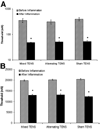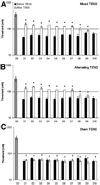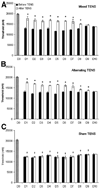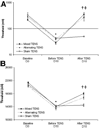Modulation between high- and low-frequency transcutaneous electric nerve stimulation delays the development of analgesic tolerance in arthritic rats
- PMID: 18374009
- PMCID: PMC2744433
- DOI: 10.1016/j.apmr.2007.11.027
Modulation between high- and low-frequency transcutaneous electric nerve stimulation delays the development of analgesic tolerance in arthritic rats
Abstract
Objective: To investigate whether repeated administration of modulating frequency transcutaneous electric nerve stimulation (TENS) prevents development of analgesic tolerance.
Design: Knee joint inflammation (3% carrageenan and kaolin) was induced in rats. Either mixed or alternating frequency was administered daily (20min) for 2 weeks to the inflamed knee under light halothane anesthesia (1%-2%).
Setting: Laboratory.
Animals: Adult male Sprague-Dawley rats (N=36).
Intervention: Mixed- (4Hz and 100Hz) or alternating- (4Hz on 1 day; 100Hz on the next day) frequency TENS at sensory intensity and 100micros pulse duration.
Main outcome measures: Paw and joint withdrawal thresholds to mechanical stimuli were assessed before induction of inflammation, and before and after daily application of TENS.
Results: The reduced paw and joint withdrawal thresholds that occur 24 hours after the induction of inflammation were significantly reversed by the first administration of TENS when compared with sham treatment or to the condition before TENS treatment, which was observed through day 9. By the tenth day, repeated daily administration of either mixed- or alternating-frequency TENS did not reverse the decreased paw and joint withdrawal thresholds.
Conclusions: These data suggest that repeated administration of modulating frequency TENS leads to a development of opioid tolerance. However, this tolerance effect is delayed by approximately 5 days compared with administration of low- or high-frequency TENS independently. Clinically, we can infer that a treatment schedule of repeated daily TENS administration will result in a tolerance effect. Moreover, modulating low and high frequency TENS seems to produce a better analgesic effect and tolerance is slower to develop.
Figures




References
-
- Rakel B, Frantz R. Effectiveness of transcutaneous electrical nerve stimulation on postoperative pain with movement. J Pain. 2003;4:455–464. - PubMed
-
- Olsen MF, Elden H, Janson ED, Lilja H, Stener-Victorin E. A comparison of high- versus low-intensity, high-frequency transcutaneous electric nerve stimulation for painful postpartum uterine contractions. Acta Obstet Gynecol Scand. 2007;86:310–314. - PubMed
-
- Sluka KA, Bailey K, Bogush J, Olson R, Ricketts A. Treatment with either high or low frequency TENS reduces the secondary hyperalgesia observed after injection of kaolin and carrageenan into the knee joint. Pain. 1998;77:97–102. - PubMed
-
- Chandran P, Sluka KA. Development of opioid tolerance with repeated transcutaneous electrical nerve stimulation administration. Pain. 2003;102:195–201. - PubMed
-
- Han JS, Xie GX, Ding ZX, Fan SG. High and low frequency electroacupuncture analgesia are mediated by different opioid peptides [abstract] Pain. 1984;18 Suppl 1:S369.
Publication types
MeSH terms
Substances
Grants and funding
LinkOut - more resources
Full Text Sources
Medical

